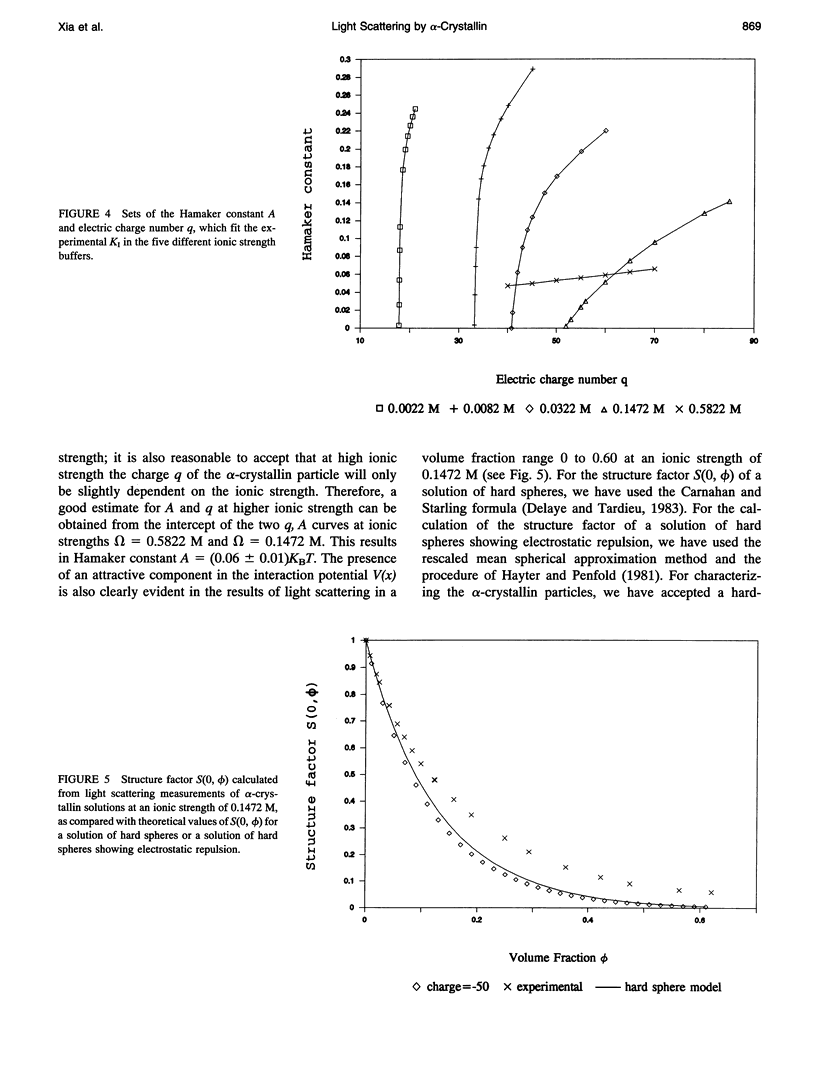Abstract
We have studied diluted bovine eye lens alpha-crystallin solutions by using light scattering. The protein particles were modeled as hard spheres, showing electrostatic repulsion, due to surplus electric charges, and weak attractive interaction. The repulsive potential VR is defined by the radius of the particles, the Debye length kappa-1, and the number of charges at the Gouy layer; the attractive potential has been described by the London-van der Waals potential and is defined by the Hamaker constant A. We have used the diluted gas approximation and the one component macrofluid model to relate the experimental static factor Ki to the theoretical expression of the interaction potential V(x). This resulted in a Hamaker constant A of 0.06 +/- 0.01 KBT and an effective charge q ranging from 18 +/- 1 at low ionic strength (omega = 0.0022 M) to 50 +/- 5 at high ionic strength (omega = 0.1472 M).
Full text
PDF











Selected References
These references are in PubMed. This may not be the complete list of references from this article.
- Andries C., Backhovens H., Clauwaert J., De Block J., De Voeght F., Dhont C. Physical-chemical studies on bovine eye lens proteins. I. Light-scattering and viscosity studies of low-molecular weight alpha-crystallin isolated from adult and embryonic bovine lenses. Exp Eye Res. 1982 Feb;34(2):239–255. doi: 10.1016/0014-4835(82)90058-6. [DOI] [PubMed] [Google Scholar]
- Andries C., Clauwaert J. Photon correlation spectroscopy and light scattering of eye lens proteins at high concentrations. Biophys J. 1985 May;47(5):591–605. doi: 10.1016/S0006-3495(85)83955-2. [DOI] [PMC free article] [PubMed] [Google Scholar]
- Andries C., Guedens W., Clauwaert J., Geerts H. Photon and fluorescence correlation spectroscopy and light scattering of eye-lens proteins at moderate concentrations. Biophys J. 1983 Sep;43(3):345–354. doi: 10.1016/S0006-3495(83)84358-6. [DOI] [PMC free article] [PubMed] [Google Scholar]
- Augusteyn R. C., Parkhill E. M., Stevens A. The effects of isolation buffers on the properties of alpha-crystallin. Exp Eye Res. 1992 Feb;54(2):219–228. doi: 10.1016/s0014-4835(05)80211-8. [DOI] [PubMed] [Google Scholar]
- Coopman S., de Block J., Aerts T., Peeters W., Moens L., Clauwaert J. Physicochemical studies on bovine eye lens proteins. II. Comparative physical study of the low-molecular-weight alpha-crystallins from calf lens cortical and nuclear fiber cells. Exp Eye Res. 1984 May;38(5):463–476. doi: 10.1016/0014-4835(84)90124-6. [DOI] [PubMed] [Google Scholar]
- Delaye M., Clark J. I., Benedek G. B. Identification of the scattering elements responsible for lens opacification in cold cataracts. Biophys J. 1982 Mar;37(3):647–656. [PMC free article] [PubMed] [Google Scholar]
- Delaye M., Gromiec A. Mutual diffusion of crystallin proteins at finite concentrations: a light-scattering study. Biopolymers. 1983 Apr;22(4):1203–1221. doi: 10.1002/bip.360220413. [DOI] [PubMed] [Google Scholar]
- Delaye M., Tardieu A. Short-range order of crystallin proteins accounts for eye lens transparency. 1983 Mar 31-Apr 6Nature. 302(5907):415–417. doi: 10.1038/302415a0. [DOI] [PubMed] [Google Scholar]
- Duncan G., Hightower K. R., Gandolfi S. A., Tomlinson J., Maraini G. Human lens membrane cation permeability increases with age. Invest Ophthalmol Vis Sci. 1989 Aug;30(8):1855–1859. [PubMed] [Google Scholar]
- Hansen J. P., Brown S. E., Sullivan R. J., Jr, Muhlbaier L. H. Factors related to an effective referral and consultation process. J Fam Pract. 1982 Oct;15(4):651–656. [PubMed] [Google Scholar]
- Harding J. J., Dilley K. J. Structural proteins of the mammalian lens: a review with emphasis on changes in development, aging and cataract. Exp Eye Res. 1976 Jan;22(1):1–73. doi: 10.1016/0014-4835(76)90033-6. [DOI] [PubMed] [Google Scholar]
- Jedziniak J. A., Nicoli D. F., Baram H., Benedek G. B. Quantitative verification of the existence of high molecular weight protein aggregates in the intact normal human lens by light-scattering spectroscopy. Invest Ophthalmol Vis Sci. 1978 Jan;17(1):51–57. [PubMed] [Google Scholar]
- Koenig S. H., Brown R. D., 3rd, Kenworthy A. K., Magid A. D., Ugolini R. Intermolecular protein interactions in solutions of bovine lens beta L-crystallin. Results from 1/T1 nuclear magnetic relaxation dispersion profiles. Biophys J. 1993 Apr;64(4):1178–1186. doi: 10.1016/S0006-3495(93)81483-8. [DOI] [PMC free article] [PubMed] [Google Scholar]
- Koenig S. H., Brown R. D., 3rd, Spiller M., Chakrabarti B., Pande A. Intermolecular protein interactions in solutions of calf lens alpha-crystallin. Results from 1/T1 nuclear magnetic relaxation dispersion profiles. Biophys J. 1992 Mar;61(3):776–785. doi: 10.1016/S0006-3495(92)81882-9. [DOI] [PMC free article] [PubMed] [Google Scholar]
- SPECTOR A., KATZ E. THE DEAGGREGATION OF BOVINE LENS ALPHA-CRYSTALLIN. J Biol Chem. 1965 May;240:1979–1985. [PubMed] [Google Scholar]
- Schurtenberger P., Augusteyn R. C. Structural properties of polydisperse biopolymer solutions: a light scattering study of bovine alpha-crystallin. Biopolymers. 1991 Sep;31(10):1229–1240. doi: 10.1002/bip.360311011. [DOI] [PubMed] [Google Scholar]
- Siezen R. J., Bindels J. G., Hoenders H. J. The interrelationship between monomeric, oligomeric and polymeric alpha-crystallin in the calf lens nucleus. Exp Eye Res. 1979 May;28(5):551–567. doi: 10.1016/0014-4835(79)90043-5. [DOI] [PubMed] [Google Scholar]
- Tardieu A., Laporte D., Licinio P., Krop B., Delaye M. Calf lens alpha-crystallin quaternary structure. A three-layer tetrahedral model. J Mol Biol. 1986 Dec 20;192(4):711–724. doi: 10.1016/0022-2836(86)90023-9. [DOI] [PubMed] [Google Scholar]
- Tardieu A., Vérétout F., Krop B., Slingsby C. Protein interactions in the calf eye lens: interactions between beta-crystallins are repulsive whereas in gamma-crystallins they are attractive. Eur Biophys J. 1992;21(1):1–12. doi: 10.1007/BF00195438. [DOI] [PubMed] [Google Scholar]
- Van den Oetelaar P. J., Clauwaert J., Van Laethem M., Hoenders H. J. The influence of isolation conditions on the molecular weight of bovine alpha-crystallin. J Biol Chem. 1985 Nov 15;260(26):14030–14034. [PubMed] [Google Scholar]
- Vérétout F., Delaye M., Tardieu A. Molecular basis of eye lens transparency. Osmotic pressure and X-ray analysis of alpha-crystallin solutions. J Mol Biol. 1989 Feb 20;205(4):713–728. doi: 10.1016/0022-2836(89)90316-1. [DOI] [PubMed] [Google Scholar]
- Vérétout F., Tardieu A. The protein concentration gradient within eye lens might originate from constant osmotic pressure coupled to differential interactive properties of crystallins. Eur Biophys J. 1989;17(2):61–68. doi: 10.1007/BF00257103. [DOI] [PubMed] [Google Scholar]


